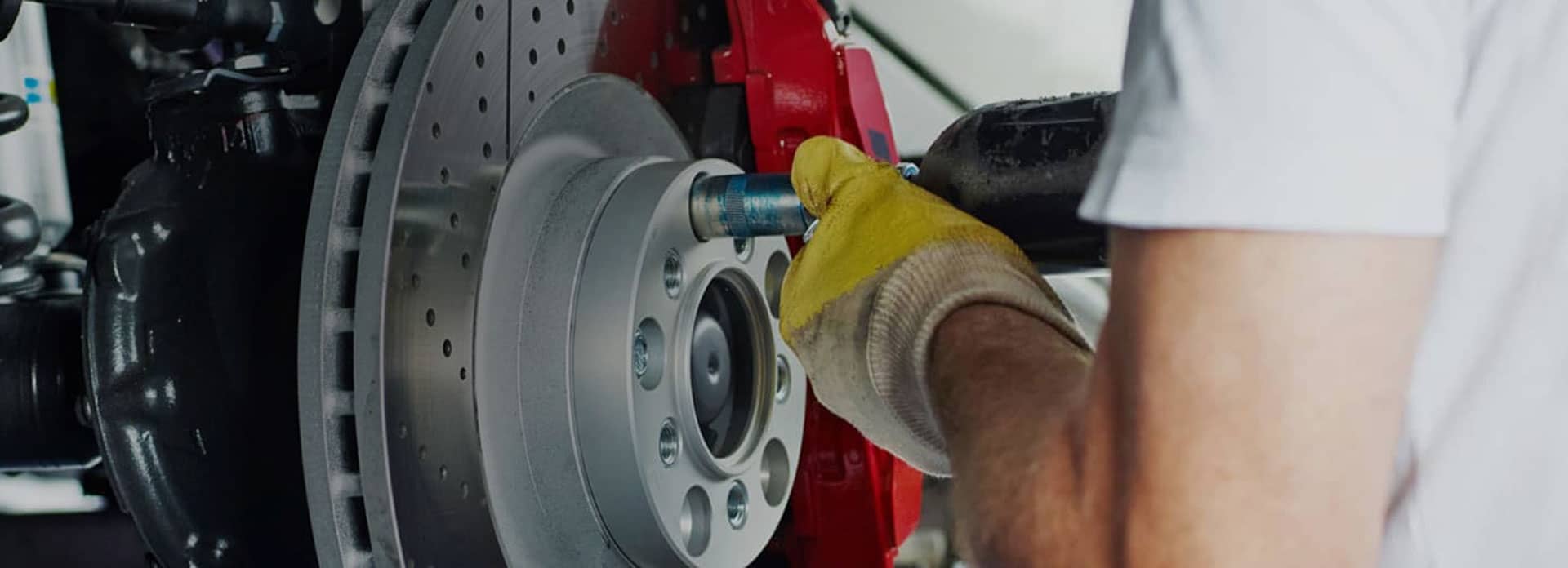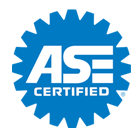Put on the Brakes: Brake Service at A.G. Automotive & Diagnosis
Posted December 31, 2023 4:27 AM
When it comes to preventive maintenance and vehicle care, most Winnetka drivers know how important it is to check their brakes. But brakes are more than just brake pads and shoes. There are a lot of components in the brake system, and they all need to be in good working order.
The pads and shoes are known as the friction materials in the brake system. They push together, providing friction which stops the vehicle. It's no wonder they have to be checked regularly for wear, and brake pads and shoes need to be replaced periodically.
Brake pads/shoes gradually wear out, but that doesn't mean your braking gradually becomes less effective. The pads are engineered so that they maintain good braking until they wear too thin to provide adequate friction. At this point, they need to be replaced.
But your braking system also has mechanical parts. These pistons and springs can also gradually wear out or get gummed up by oil, dirt and other road spatter. A brake inspection at A.G. Automotive & Diagnosis in Winnetka includes a check of these parts as well as the pads and shoes. Your friendly and knowledgeable pros at A.G. Automotive & Diagnosis can then advise you of any parts that need cleaning or replacement.
The fluid component to the brake system needs a regular check-up at A.G. Automotive & Diagnosis as well. The brake fluid cools and protects your brake system. Protective additives are gradually depleted by the operation of the brake system, and moisture buildup inside the fluid can diminish its effectiveness. When you have your brakes serviced at A.G. Automotive & Diagnosis in Winnetka, the fluid should be checked and, if needed, replaced, which will clean out water, debris and dirt.
It is important to remember that your brake system also includes your tires. No matter how well your brake system is performing, if your vehicle tires are worn, you won't get good stopping power. Traction is the power of your tires gripping to the roadway. Traction is always better on tires with a good tread. Good traction translates to good braking.
This is particularly important on wet Winnetka roads. A good tire will give you good braking on either wet or dry CA roads. But stopping distance increases dramatically when worn tires meet wet roads. Tread on a tire acts to channel away water as the vehicle passes over the wet road, improving contact between the tire's surface and the road; that maintains traction. But the thinner the tread, the less effective the water channels become, and water can get between the tire and the roadway, reducing friction. A loss of friction means a longer stopping distance and possibly the loss of control.
Braking depends on two things: the weight of your vehicle and the speed of the vehicle. The heavier the vehicle or the faster the vehicle, the more braking power it requires. Thus, brake systems vary from vehicle to vehicle. For example, a pickup that is designed for heavy loads has a more powerful braking system than a compact car. Sports cars also have higher-grade braking systems than minivans.
Regardless of what kind of car you drive in Winnetka, it is always good auto advice to keep your brake system in good repair, and that means ALL of your brake system. Just one more way to keep your travels accident- and worry-free.
A.G. Automotive & Diagnosis
19735 Sherman Way Suite 2
Winnetka, CA 91306
(818) 438-9608
http://www.agautodiagnosis.com
Protecting Your Vehicle from Theft in Winnetka, CA
Posted December 24, 2023 7:57 AM
Every car in Winnetka, CA, is at risk for theft. So it's up to us to make our cars a less appealing target and more of a challenge – hopefully sending potential thieves to look elsewhere.
The National Insurance Crime Bureau recommends a layered approach to protecting vehicles:
- Common sense
- Visible and audible devices
- Immobilizing devices
- Tracking devices
Let's review each of these. One is common sense; you would be surprised how many vehicles are stolen in CA where the keys were left in the ignition with the doors unlocked. Always take your keys and lock the doors. In fact, in some places it's against the law to leave a vehicle unattended with the keys in the ignition.
And don't leave spare keys in the car or hide them outside – because a thief will find them. Winnetka drivers would be wise to park in well-lit areas that have a lot of foot traffic. If possible, park near the end of a row and near a light. Back your car into a parking space or your driveway to make your car more visible to passersby and harder for a thief to work under the hood without being seen.
People in Winnetka should know that it's important to roll up their windows completely and avoid leaving their car in public lots for a long time. If you park in a lot that has an attendant, only give them the ignition key.
Keep valuables out of sight; purses, wallets, cell phones, clothes and even change are attractive "smash-and-grab" targets. And pay to have your Vehicle Identification Number, or VIN, etched into your windows – it makes your car less attractive to a thief who wants to send your car to a chop shop.
There are lots of visible and audible devices available for Winnetka drivers. A steering wheel lock is highly visible and will deter some thieves. Loud alarms can alert you and others that your vehicle is being tampered with. But if your alarm does go off, be careful. Observe what's going on; get descriptions of suspicious people and vehicles, including license plate numbers.
Now, if you catch a thief in the act, call 911 but don't approach the person. Your safety is more important than the car.
And here's a great one - immobilizing devices. They actually shut off your car's electrical or fuel supply. So without a key, or knowing where the hidden switch is located, a thief can't drive your car away.
Finally, drivers can also get a tracking device that allows Winnetka police to track their car down and recover it quickly.
Remember, where you live, work and drive around Winnetka, CA, has a great impact on your decisions. If you're in an area with high theft rates, you may want to spend more money on security systems. And check with your auto insurance company to see if they offer discounts for adding any of these items.
Of course, the common sense suggestions from A.G. Automotive & Diagnosis don't cost anything and go a long way toward keeping your car safe from thieves.
A.G. Automotive & Diagnosis
19735 Sherman Way Suite 2
Winnetka, CA 91306
(818) 438-9608
http://www.agautodiagnosis.com
How Much is Enough for Winnetka Auto Owners? Tire Tread Depth
Posted December 17, 2023 4:51 AM
Most Winnetka drivers know that tires wear out and that the wear has to do with tread depth. Most of us have heard that “bald” tires are dangerous, but most of us picture a tire with no tread at all when we think of a bald tire. And when we take our vehicles in for preventive maintenance, the technician tells us they're need to be replaced long before all the tread is worn off. Just how much tire tread wear is too much? And how can you tell? Tires are and their condition is important to the safe handling of a vehicle, so it's for Winnetka vehicle owners to know the answers to these questions.
First of all, it's important to understand that there may be a legal limit to tread wear. If your tires are worn past this limit, you have to replace them to be in compliance with CA auto safety laws. That's why measuring your tread wear is part of a vehicle safety inspection.
In some jurisdictions, tread must be at least 1.6 millimeters or 2/32 of an inch thick. This standard has been in effect since 1968. But this standard has recently been called into question, and some CA professionals are arguing that it be changed.
The safety issue that has brought this standard under scrutiny is the ability of a vehicle to stop on a wet surface. When a vehicle has trouble stopping, most Winnetka drivers immediately look at the brakes as the source of the problem. But tires are crucial to safe stopping distances because they provide the traction required in a stop.
A tire's contact with the road surface creates traction, which allows for effective braking. On a wet surface, a tire only has traction if it can get to the road's surface. So tire tread is designed to channel water out from under the tire to allow it to stay in contact with the road. If the tire can't shift the water, then it starts to “float.” This condition is called hydroplaning. It is very dangerous for Winnetka drivers since the vehicle won't stop no matter how hard the driver presses the brakes. Steering control is also lost.
A recent study tested the stopping ability of a passenger car and a full-sized pick-up on a road surface covered with only a dime's depth of water (less than a millimeter). The vehicles were traveling at 70 mph (112 kph) when they stopped on the wet surface. At 2/32 (1.6 mm) tread depth, the stopping distance was double that of a new tire. The passenger car was still traveling at 55 mph (89 kph) when it reached the stopping distance it experienced with new tires.
Let's suppose that you're on a busy Winnetka road in a light drizzle and a vehicle stops suddenly in front of you. You just bought new tires and you brake hard, missing the vehicle with only inches to spare. If you hadn't bought those new tires, you would have crashed into that vehicle at 55 mph (89 kph). That is a major difference.
What if your tires had a tread depth of 4/32 (3.2 mm)? You would have crashed into that vehicle at 45 mph (72 kph). Still not a good situation. But it's better.
Now what if you were driving that pick-up truck? You wouldn't have missed that vehicle in the first place, and you would have crashed at higher rates of speed in both of the other scenarios. The heavier your vehicle, the longer its stopping distance. It's a matter of physics.
The results of this test has led Consumer Reports and others to ask that the standard for tread wear be changed from 2/32 (1.6 mm) to 4/32 (3.2 mm). The increased standard will improve safety on the road and save lives here in CA and nationally.
Of course, until the standard changes, you'll have to decide whether you'll be willing to replace your tires a little sooner.
You can use an American quarter to tell if your tread wear is down to 4/32 (3.2 mm). Place the quarter into the tread with George's head toward the tire and his neck toward you. If the tread doesn't cover George's hairline, you're under 4/32 (3.2 mm). With a Canadian quarter, the tread should cover the digits of the year.
You can measure the 2/32 inch (1.6 mm) tread wear with a penny. If the tread touches the top of Abe's head, it's at 2/32 (1.6 mm). Tires are super important when it comes to vehicle care. But their condition has a major impact on safety. We need to decide whether to sacrifice safety for economy. Keeping our tread wear above 4/32 in (3.2 mm) is good auto advice.
A.G. Automotive & Diagnosis
19735 Sherman Way Suite 2
Winnetka, CA 91306
(818) 438-9608
agautomotivediagnosis.autotipsblog.com
Don't Start with That (Bad Starter Motor)
Posted December 10, 2023 7:29 AMWe've all heard that expression, "That's a non starter." When it comes to your vehicle, that's not music to a driver's ears. That sickening sound when you start the ignition and instead of hearing the engine crank, you hear it slowly turn over and your dash lights go dim.
There can be many reasons a vehicle won't start, so here's a little history of how the starter came to be an important component of modern vehicles.
You have to move the engine's components to start it. The first cars had a crank that the driver would insert into the front, then start turning things over by hand. When the engine started, you had to release that crank immediately or risk a broken arm. Yes, it happened many times. So, they came up with a better idea: an electric starter, which was a big advance in automotive technology.
With this system, an electric motor rotated a series of gears that turned the gasoline engine's crankshaft so its pistons and parts moved and the engine drew in air. While this happened, electricity went to the spark plugs and fuel headed to the cylinders. When the gasoline engine caught, the starter quickly disengaged. Hey, no more broken arms!
Modern systems use the same principle, so when your vehicle won't start, here are a few things to look out for that might point to the starter.
If the engine turns over s-l-o-w-l-y, it may mean the electric starter motor may just be wearing out and doesn't have enough cranking power. Bushings, brushes, wire windings and a special switch called a commutator may be going bad.
If when you engage the ignition you hear a faint click, that could be a symptom one or more of the starter's components have failed. If you hear a loud click, it could mean that an electrical switch called a solenoid may not be switching the motor on.
If you hear your engine start to turn over but then it stops and is followed by a grinding sound, some gears may not be meshing the way they should.
There may be many more causes (bad alternator, relay, battery, engine, key fob), so this is when it's time to turn it over to your service facility. Sometimes they can send out their own tow truck or recommend a reputable towing company.
But it's best not to let it get to this point. Starter problems often give you advance warning that there is a problem with "almost" not starting or "almost" not turning over. So when you see that very first sign, "start" on over to talk this one over with your service advisor. The opposite of a "non-starter" is a starter, and that is music to anyone's ears.
A.G. Automotive & Diagnosis
19735 Sherman Way Suite 2
Winnetka, CA 91306
(818) 438-9608
http://www.agautodiagnosis.com
Can Your Car Last Another Year?
Posted December 3, 2023 8:53 AM
Have you checked out the price of new vehicles at Winnetka car dealers? Ouch! Add financing and insurance and a new ride may not seem so attractive. A lot of Winnetka, CA, folks are hoping to make their cars last a lot longer.
Fortunately, with the current state of automotive engineering and manufacturing, there's no reason a modern vehicle can't be made to last for a 150,000 miles (250,000 kilometers) or more for smart Winnetka drivers.
The old adage: 'a stitch in time saves nine' is really true for Winnetka residents when it comes to car maintenance. A great example is coolant service.
Over time, coolant becomes corrosive and actually starts to damage your radiator and other parts. Smart Winnetka drivers have their cooling system service taken care of right on schedule at A.G. Automotive & Diagnosis.
Ditto for your power steering system, brake fluid, air conditioning system, differential and transmission. Of course, oil changes should be done right on schedule to avoid the build-up of harmful oil sludge.
Don't let your brake pads go too long before they are worn to the point that your rotors are at risk. Preventative auto maintenance at A.G. Automotive & Diagnosis is a great way to keep your operating costs down.
Replacing belts and hoses is much cheaper than repairing the damage that can be caused by failure.
We know that this is a lot for busy Winnetka area drivers to remember. Let the team of automotive professionals at A.G. Automotive & Diagnosis keep on top of this stuff for you. We can tell you what your vehicle manufacturer recommends and help you develop an affordable plan to take care of it.
Bottom line – do routine maintenance on schedule and you will reduce operating costs, prevent repairs and maintain your warranty coverage.
Let us take good care of your car at A.G. Automotive & Diagnosis in Winnetka, and it'll take good care of you.
A.G. Automotive & Diagnosis
19735 Sherman Way Suite 2
Winnetka, CA 91306
(818) 438-9608
http://www.agautodiagnosis.com















